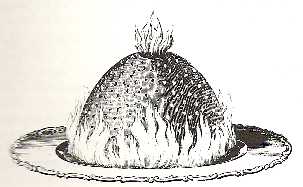 |
Traditional Plum Pudding (makes 5 x 1lb/450g puddings) |
 |
 |
Traditional Plum Pudding (makes 5 x 1lb/450g puddings) |
 |
| Ingredients: 8oz (225g) large prunes |
Plum Pudding did not become
associated with Christmas fare until the nineteenth century when Prince Albert introduced it, because he was so fond of this heavy rich pudding. |
|
| nnnnn | Plum porridge or pottage was the
earliest form of plum pudding and dates back to medieval times. This was made from meat, usually shin of beef and veal, stewed together with currants, raisins, prunes (the dried plums which give their names to the mixture), spices, sugar, sack (a once popular wine from the Canary Islands), lemon juice and claret. The whole thing was thickened with brown breadcrumbs or sago. By the nineteenth century meat had been left out and the pudding became more like our modern-day Christmas pudding. |
|
| The idea of putting silver
trinkets and charms into the pudding probably came from the earlier tradition of the beans inside the Twelfth Night Cake, but this has since died out. It is still traditional to bury a silver coin, if you have one, in the mixture. All the family should stir the pudding in turn on Stir Up Sunday, the Sunday before Advent, and make a wish at the same time. The coin should then be pushed in, plus a ring and a thimble; the coin is to bring worldly fortune, the ring a marriage and the thimble a life of blessedness. |
| Method; |
| Soak prunes overnight in cold tea. Next day, drain, remove stones and chop finely. The addition of prunes gives a richer, darker colour to the pudding as well as a very good flavour. Wash and dry all remaining dried fruit and stone raisins if necessary. |
| Sieve flour, salt, baking powder and spices together into a very large bowl. Add breadcrumbs, sugar and suet, mixing in each ingredient thoroughly. Gradually mix in all the dried fruit, candied peel and nuts. Stir in the rind and juice of the lemon and orange, followed by grated carrot and apple. Pour in the stout and mix until smooth. Cover basin with a clean cloth and leave in a cool place overnight or longer if convenient (the flavour will be improved). In fact, the mixture can be left to stand for a fortnight or longer at this point. Stir mixture every day if you decide to do this. |
| On the day you want to cook the puddings, add the beaten eggs. Stir furiously until the pudding ingredients are thoroughly blended. Add enough rum to make a soft dropping consistency. Spoon mixture into greased pudding basins to come within I in (21/2cm) of rim, packing mixture down well with the back of a wooden spoon. You will need 5 x I lb. (450g) basins or 2 x 21b (900g) and 1x1 lb. (450g) basin. Cover the top of each with greased greaseproof paper. Put a thick layer of flour on top of the greaseproof paper, pressing it down well. (This will become a solid paste and act as a seal both for cooking and storing.) Then cover with another piece of greaseproof paper. Finally, cover basins with a pudding cloth, muslin or aluminium foil, making a pleat in the centre to allow room for puddings to rise during cooking. Tie securely with string and make a handle of string across the top of each basin, so that you can lift the puddings in and out of the pan easily. |
| Place puddings in a steamer, double boiler, or in a large pan of gently boiling water. Steam for at least 6 hours, topping up water level from time to time with boiling water. When cooked, remove puddings from pan and leave until cold. Renew top piece of greaseproof paper and cloth and store in a cool dry place until needed. |
| On the great day, steam again for 2-3 hours before serving. Turn out on to a large platter. Sprinkle with icing sugar. Heat some brandy, whisky, rum or Kirsch in a small saucepan or ladle. Pour over pudding and set alight. Bring the pudding to the table, burning, and surrounded by a hedge of holly. Any spirit can be used, but you will find that rum burns longer. Make sure your holly doesn't go up in smoke! | ||
 |
 |
|